Rain! Finally! It poured on and off all night. While that's hardly optimal for travelling, it is good for everyone and everything else.
Breakfast was wonderful... poached eggs, fried mushrooms and tomatoes, fresh fruit from the garden, toast, honey, jam, plum sauce... a real feast!
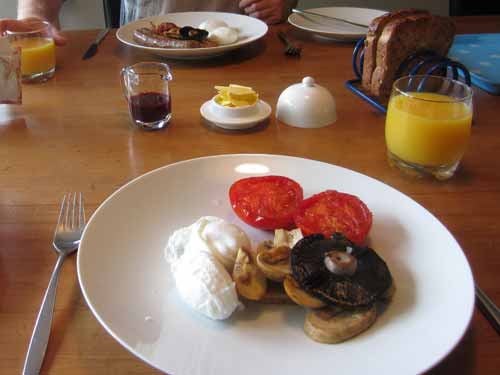
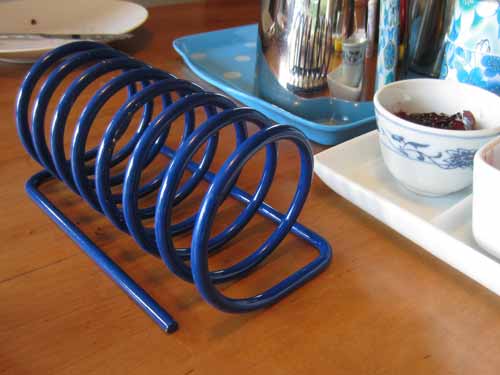
The sinister toast rack, designed to create cold, hard, dry toast
We had originally planned to a short hike but figured that wouldn't be as nice in the rain (especially since neither of us had brought any rain gear). So we opted to drive downtown and perhaps find a place on the waterfront to have a nice St. Patrick's Day beer. We packed up, said our farewells to Mary and Mark (and the cats), and headed out.
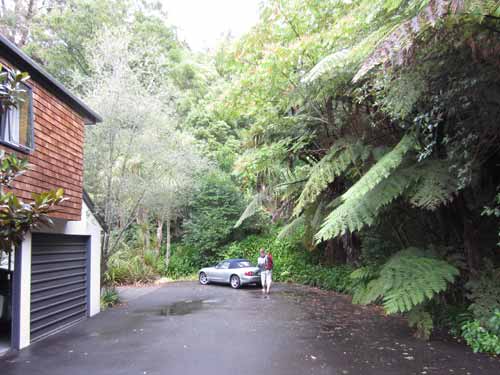
Packing up the car. The entire house was surrounded by thick, enormous vegetation!
Downtown was a disaster! Most of the streets were blocked off for what appeared to be a motorcycle club parade. There was also a monstrous cruise ship parked a few blocks away. Eventually we got out of the downtown (in spite of numerous roads being closed)... only to have Regan say with a hint of urgency in his voice that we needed to find a gas station. I glance over and sure enough, the "empty" light is glowing. We tried driving to what looked like civilization to keep ending up in residential sections. We finally resorted to using the GPS on the phone to find the nearest one. Fortunately we reached one with the few fumes we had left.
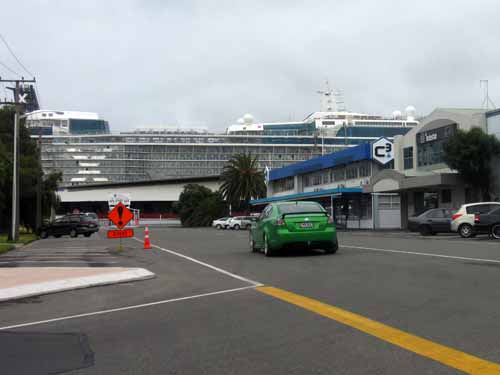
What looks like high-rise apartments is actually the cruiseship!
We stopped by the retirement home to visit Zoe, his grandmother. We first went to the library to find someplace other than her tiny room to talk... but that was being set up for lunch. We peeked into a couple of the other gathering rooms but they were filled with folks watching tv. So we headed toward the other end of the building. On the way, we stopped and looked at the turtles that lived in a bathtub sunken into the garden. It started raining again so we moved back inside.

It's hard to tell how steep this hill is, but trust me, no elderly person is making it out of there alone!

The turtles in the midst of a comical routine of stepping all over each other
We found a relatively quiet spot in a glass-covered walkway between two buildings. It was nice to be able to watch the rain yet not have to be in it. Regan asked her questions about her life, and she told us wonderful stories from 70 years ago... the war, the bookshop, the kids, etc. After a little while, another elderly lady walked up and asked if she could join us in the one free chair left. Uh, sure. We quickly learned that she was almost completely deaf, so she wasn't interested in Zoe's stories (not to mention she even seemed a bit perturbed that Regan was "talking too quietly"). So she simply continued to mention that it was almost time for lunch. It didn't matter what you answered, she'd say the same thing a minute or two later. Fortunately it really WAS almost time for lunch so she got up and left. We grabbed another few minutes of conversation before walking Zoe to the dining room. It was there we parted from her and began the long hill up to the car. The rain had slowed to a drizzle, so we were lucky.
The rain got worse and worse as we headed down to Te Puke. I had talked Regan into going on the kiwi farm tour. By the time we got there, it had eased up a little bit.
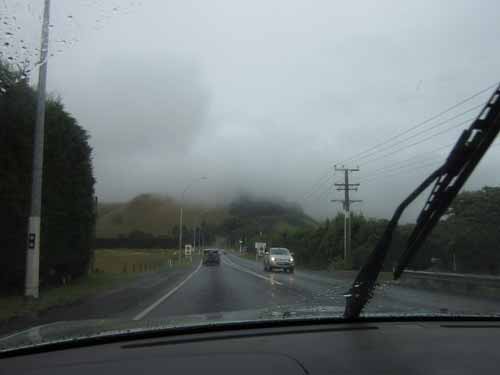
The clouds were low and the drops were plenty!
Since the next tour didn't start until 1 pm, we first did some tasting of kiwi fruit, juice, wine and even liquor.
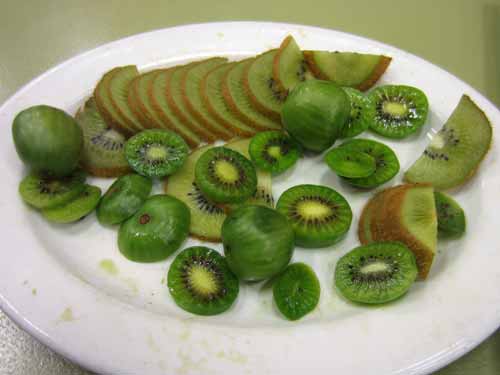
Different types of kiwis, including kiwi berries. We learned that the reason we can only find fruit from USA and Italy in the local stores is because New Zealand has completely sold everything they have! They are expecting to do another harvest in a couple of weeks, so perhaps we'll see the native fruit back in the stores at some point next month.

Tasting the crisp, yummy kiwi wine
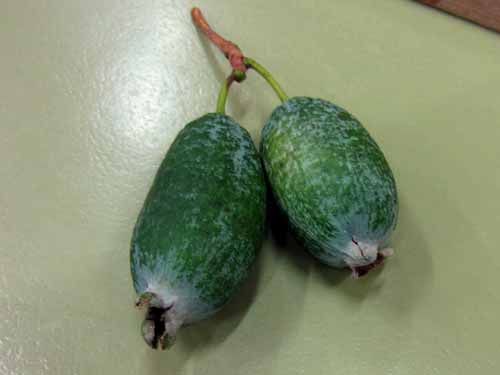
The Feijoa is another very yummy fruit used in many of the same things kiwis are.
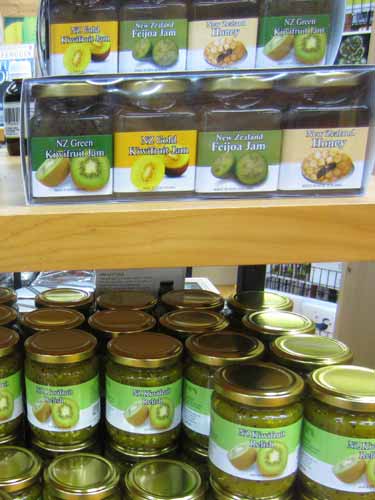
Kiwi jams and other delicious things!
It was then time to load up into the little tram. It had a top on it but the sides were open. Cindy, our tour guide, gave us umbrella and towels, just in case. There were only 4 of us total. Apparently all the people from the cruiseships in town had done the earlier tours.
We first headed through a wide variety of other fruit trees and bushes. We would stop along the way, sometimes even being allowed to get out and sample something yummy.
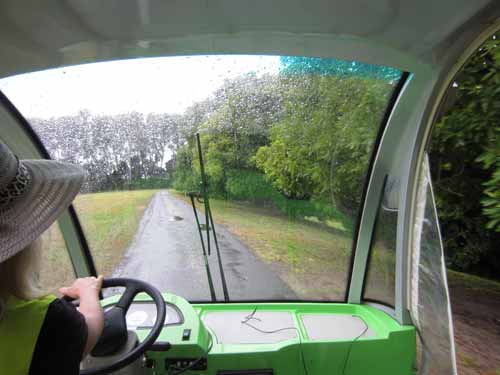
The tram tour through the various fruit trees
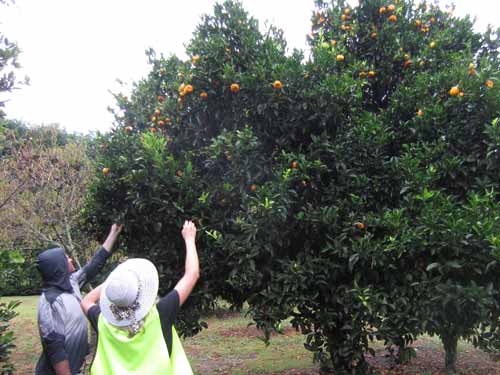
Picking fresh, yummy fruit...

... such as this Pineapple Mandarin...
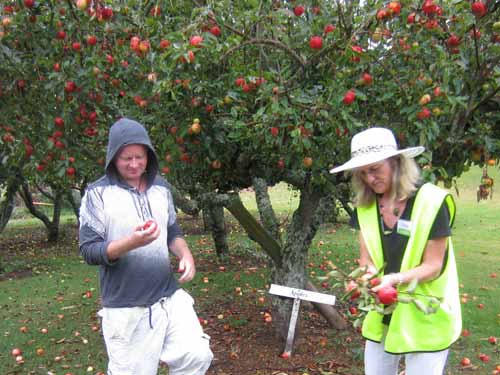
... or these Gala Apples.
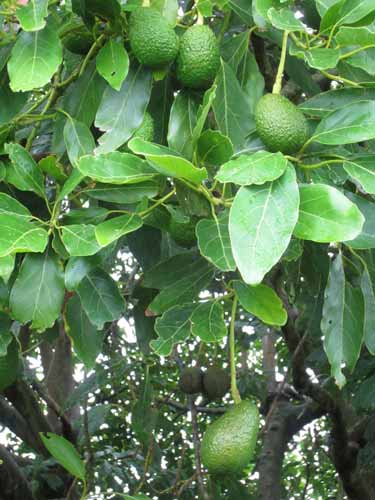
Avocados will never ripen on the tree. They MUST be picked to ripen, but they are usually picked too early in most countries.
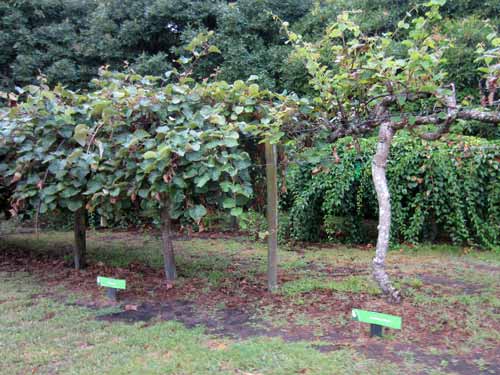
Different kiwi fruit varietals
Now we got the heart of the tour... the actual kiwi fruit trees, or rather they would be more like giant trees except that the vines are trained and limited to low trellises. We drove past several orchards of them. A pre-recorded audio tape spilled forth a vast array of information on the fruit, the harvesting, the, well, everything.
We first stopped at one spot where new vines were being trained. Apparently this section had gotten hit with PSA (a fruit virus), so everything had to be destroyed to prevent it from spreading. New vines were grafted onto the thick old roots. This was just under one year of growth. The vines can grow up to 6 inches per day. The wires run upwards so the vines get as much sun as possible. Once they are established, there are unwrapped and trained along the horizontal lines (a pergola). It takes several years before the fruit actually starts being produced.

The training vines
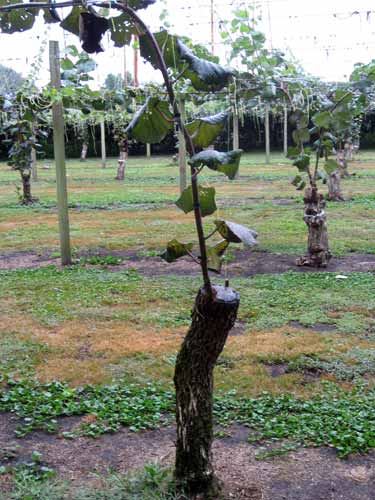
The new healthy stalks are grafted to the established roots.
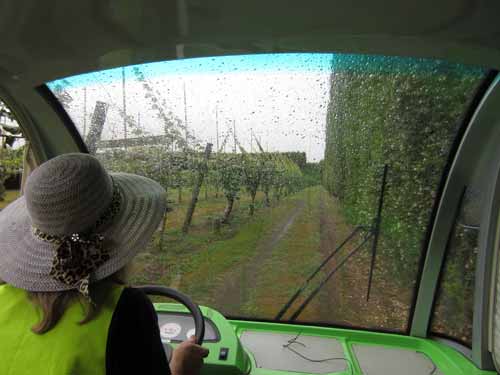
The orchard is protected by dense rows of trees which serve as windbreaks. If the fruit were to be bumped around by the wind, they could get "shoulder rub" which would rub off their fuzz and make them unmarketable.
We then moved to another set of vines and allowed to get out of the tram and see the fruit close up. The rain dripped through the leaves onto us.
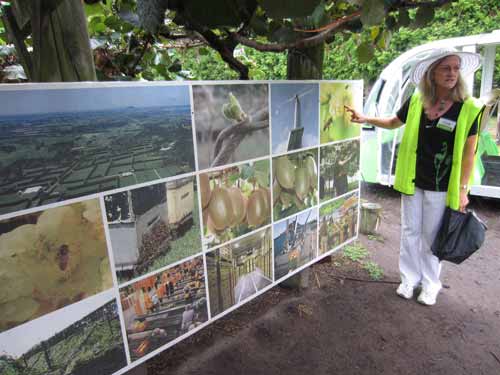
Learning some facts about the kiwi:
- The plants are not self-pollinating. For every 10 or so female vines, there is 1 male vine.
- Kiwi fruit originally came from China in 1904 as the Chinese Gooseberry.
- The fruit is harvested from April - June. The normal number of workers year-round is about 6,000. That number jumps to 25,000 during harvest time. They mostly use people from Asia (being short is a definite advantage!) but they also hire backpackers. Hmmm... a new workaway job??
- The plants need a little bit of frost, but giant fans placed around the orchard prevent amounts that could be damaging.
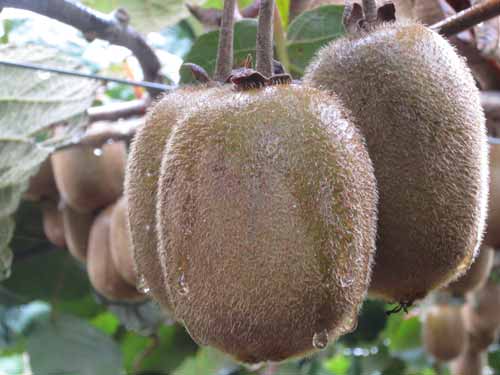
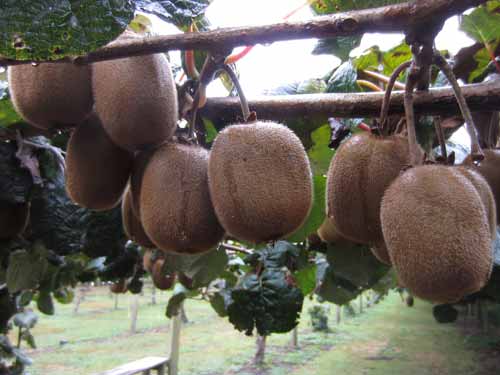
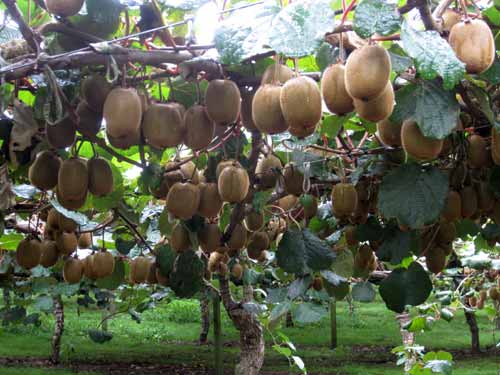
Lots...
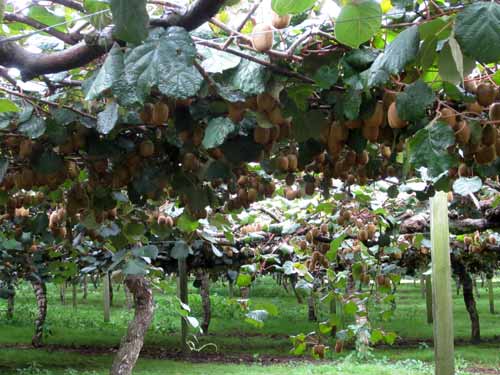
... and LOTS of fruit!
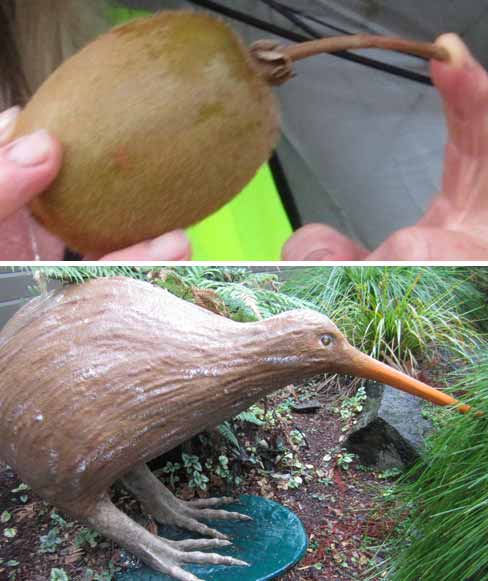
How the kiwi fruit got its name?? Your call.
After the tour, we bought some feijoa chocolate and kiwi wine, and then headed back onto the road in the rain. We stopped in Rotorua to celebrate a quick St. Paddy's Day, grabbed some fries and sandwiches (egg salad and cheese&onion) for the road, and continued on. We thought briefly about stopping to see some glass blowing, but with the weather being what it was, we decided to not waste any more time. Eventually the clouds let up briefly but then closed back in as we approached Wellington.
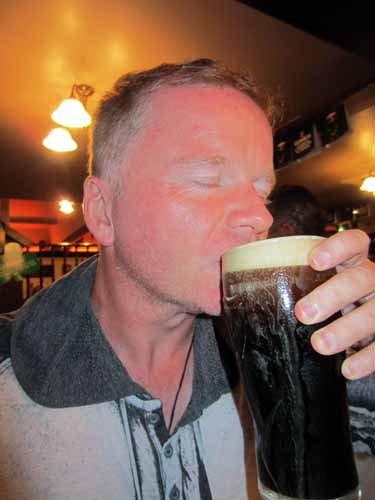
Sharing a glass of Guinness
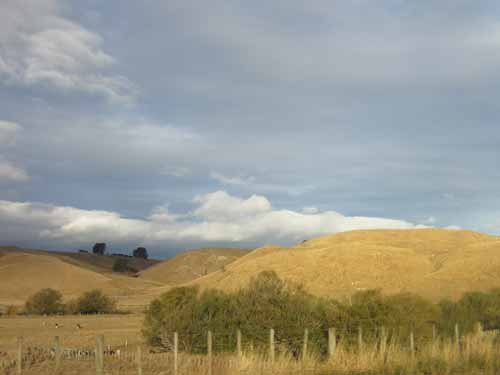
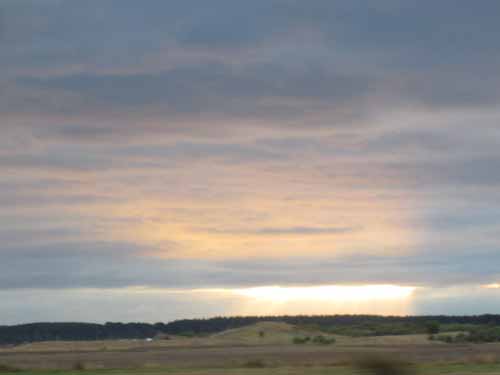
The fading light
We got home around 9 pm, quite exhausted. It was amazing how just 2 1/2 days could feel like a week!

